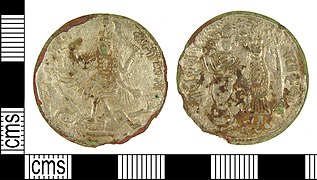|
Indian temple tokens The Indian Temple tokens are token coins popular at temple and pilgrimage sites in India. They are also known as Rama-tankas ("Rama coins"), as several of them feature the Hindu deity Rama. Other names for these coins include ram-tenki, ram-tanka, and ram-darbar.   HistoryThe earliest of the Rama-tankas may have been actual coins (not token coins or medals). The coins issued by the 12th century Chahamana king Vigraharaja IV can be considered as a precursor of the later Ramatankas.[1] The earliest extant mention of the Rama-tankas can be found in the Dravya-Pariksha (1318) of Thakkar Pheru, a mint-master of the Delhi Sultanate. Pheru describes the gold coins known as Sita-Rami.[2] Historically, the coins appear to have been used for exchange. For example, a record from the Vijayanagara Empire mentions that "10,080 Rama-tanki varahas, 2000 Lakshmi-pati varahas, and 10,050 Puttalikas" were spent on the foundation of a new village called Kunidi. Thakkar Pheru also suggests that the rama-tankas were used for exchange, when he states that if a Sita-Rami coin is "ten mashas in weight and ten ban gold, it is worth being kept for worship and not to be exchanged."[3] Common stylesA series of gold Rama-tankas, originating in the Vijayanagara Empire, feature the scene of Rama's coronation. These coins are now used as objects of worship in the modern Indian homes.[4]
A popular silver token, found at Ayodhya and other pilgrimage centres of north India, features images of Rama and Lakshmana with a legend on the obverse, and depicts Rama's coronation on the reverse side.[5] On the obverse, Rama and Lakshmana are depicted wearing a dhoti, both wearing crowns, and holding a bow on their left arms. Rama is shown with a trident in his right hand. The legend surrounding them reads Rāma Lachamana Jānaka java(ya)ta Hanamānaka ("Victorious are Rama, Lakshmana, Sita, and Hanuman"). The tokens also bear a date that reads 17 śana 40, which probably means Vikrama Samvat year 1740, that is, 1683 CE. On the reverse, Rama and Sita are shown on a throne, under a chhatra. They are flanked by Lakshmana on right, Bharata and Shatrughna at the left, and Hanuman at bottom.[6] A variant of this token shows tridents in the right hands of both Rama and Lakshmana, and bears the date 517-40, which may refer to the year 51740 of a fictitious calendar era.[7] The Rama-tankas are generally associated with Rama, but similar temple tokens featuring other deities also exist. For example, a silver token that probably originated at the Jagannath Temple in Puri, features the triad worshipped at the temple.[5] The obverse depicts the triad (Jaganatha, Subhadra, and Balarama) standing, with the Sanskrit legend śrī-śrī-Jagannāthasvatrayi ("the Jagannatha triad") in Devanagari script. The reverse features Rama's coronation scene; variants with the 517-40 date also exist.[8]  Temple tokens not featuring Rama at all also exist.[5] For example:
ReferencesWikimedia Commons has media related to Indian temple tokens.
Bibliography
Further reading
External links
|
Portal di Ensiklopedia Dunia



